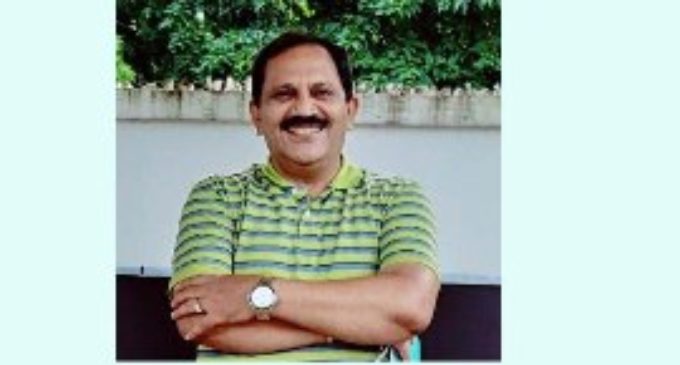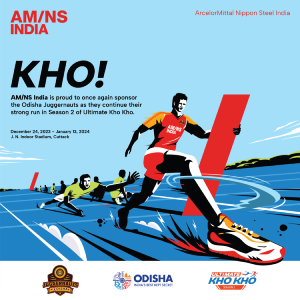Gopabandhu Das ; popularly known as Utkalamani (Jewel of Utkal or Odisha)

By Er Taraprasad mishra
Jajpur, Octo 9 : Gopabandhu Das was born on 9 October 1877 in Suando village, near Puri, Odisha in then British India. His mother was Swarnamayee Devi, the third wife of Daitari Das. His father was a mukhtiar and the family were reasonably well-off. Das married Apti at the age of twelve but continued his education. He had basic schooling in the village before progressing to a middle school nearby.
Then, in 1893, by which time his mother had died, Das joined Puri Zilla School. There he was influenced by Mukhtiar Ramchandra Das, a teacher who was both a nationalist and a proponent of public service in aid of people in distress. Becoming organising his fellow children in the spirit of co-operation, the inadequate response of authorities for the victims of an outbreak of cholera prompted him to start a voluntary corps called Puri Sava Samiti.
Its members helped those suffering from the outbreak and also cremated the dead. Das, whose father by now had died, progressed to Ravenshaw College in Cuttack. He became a regular contributor to local literary magazines called Indradhanu and Bijuli, where he argued that any modern literary movement, just like any modern nation, could not be a clean break with the old but rather had to acknowledge and base itself on its past.
In one instance, he submitted a satirical poem that so enraged the Inspector of Schools that Das was punished when he refused to apologise for it. It was while at Ravenshaw that Das started a discussion group, called Kartavya Bodhini Samiti (Duty Awakening Society), in which he and his friends considered social, economic and political problems. It was also during this time, in 1903, that he attended a meeting of the Utkal Sammilani (Utkal Union Conference), where he disagreed with Madhusudan Das’s suggestion that Odia-speaking areas should be amalgamated with Bengal Presidency.
These extra-curricular activities, which also included helping the victims of flooding, impacted on his academic studies such that he failed his degree examination, although he gained his BA at the second attempt. It was also while at Ravenshaw that his new-born son died;[2] he explained his preference to deal with flood victims on that occasion rather than be with his sick son as being because “There are so many to look after my son.
What more can I do? But there are so many people crying for help in the affected areas and it is my duty to go there. Lord Jagannath is here to take care of the boy”.Das progressed to Calcutta University, where he obtained an MA and LL.B while simultaneously devoting much of his energies in attempts to improve the education of Oriya people who were living in the city, for whom he opened night schools.
His desire to bring about social reform and educational improvements was influenced at this time by the philosophy of the Swadeshi movement. His wife died on the day he heard that he had passed his law examinations. Now aged 28, all of his three sons had died and he chose to give up care of his two daughters to an older brother, along with his share of property in Suando.
The architect of modern Utkal, a great educationist, a nationalist, the founder of Satyabadi system of education popularly known as Satyabadi Bana Bidyalaya, the Utkal mani, the saviour of the poor and destitute, an eminent patriotic poet, a front line social worker, Gopabandhu Das was born at Suando village near Sakhigopal police station in the district of Puri, Orissa.
Daitari Das and Swarnamayee Devi were his parents. His mother died soon after the birth of Gopabandhu and he was brought up by his paternal aunt. Amidst adversity he completed matriculation in 1899 from Puri zilla school and entered Ravenshaw College to study Arts. After graduation, he pursued law degree in 1906 and he successfully completed it.
But, he did not thrive on law profession. Having realised the pitiable plight of people of Utkal in every aspects of their lives, he thought that education would solve the myriad problems of oriyas and thus he experimented his educational ideas at Sakhigopal on 12th August, 1909. This institution was named as Satyabadi System of education or Vana Vidyalya.
He dedicated the rest of his life for the upliftment of pupils and people. His enduring social service to the poorest of the poor, destitute and deserved during natural calamities like flood, famine and fire gives him a indelible mark of a true social worker believing in deeds but not words.
In the political arena, he took the leadership of our struggle for independence and he sustained a life of prisoner many a times. He was the mainspring behind the organisation of Utkal Sammelan-to give Utkal a separate identity-which came into existence on April 1, 1936. When Orissa emerged as a separate province. Since, he was a practical educationist, let’s discuss his educational ideas and practice as under.
Gopabandhu’s educational thought is a replica of his general philosophical ideas. He termed education as a real panacea for a number of maladies. According to him, “By education, I do not mean the teaching in school; education is what was imparted in the ancient Indian institutions and centers of religion throughout the province.”
Therefore, his educational system was based upon the pillar of ancient Indian system; aimed at developing a host of universal qualities – self-control, non-violence, dedicated and selfless service, patriotism, fearlessness, humanism, righteousness, character and belief in religion.
When open-air school was established, Gopabandhu assertively said, “It is the belief of the organizers of the Universal Education league that everyone has the equal right of being educated just as the rays of the sun and moon are shared equally by the people and just as religious instruction is being imparted to the human society in all ages, education or mental illumination should also be given equally to all.”
Being realised that India as a poor country, cannot provide education to the entire population, he thought that education should be as far as possible inexpensive. Therefore, he said, “There are several ways of reducing educational expenditure without deteriorating educational standards, and for this attempts are being made to establish a grove school on the lines of old Gurukul system with no buildings at all.In this institution, the tuition fees payable by the students shall be minimum and they will be made live a simple and austere life in the school hostel”.
As such, he convinced that education to be universalized should be inexpensive as far as possible. The then system of education was theoretical out and out. Because, it was the inefficiency of the then education system to prepare the young-men of the country for the struggle of life. They were not capable of doing anything other than that could be done with chairs and tables.
Therefore, he wanted education to be practical which could enable the pupils to become self-reliant economically. He said that for making them earn their livelihood, the students should be taught not only physical exercise but also some of the crafts especially industry and agriculture.
His educational aim was not producing craftsmen or workmen but men of cultured and civilized. He wanted liberal education to all for a growth of cultured society. He remarked, “There is a great need for religious and moral instructions, for morality has value even in material activities like trades and commerce.”
He was a votary of social service and said that education was not a passport for a lucrative career or an approach to material facilities only, but he regarded education as a platform for preparation of students to dedicate their lives for the sake of the humanity and the nation. He also emphasised on education for bringing about national feeling among the pupils.
He believed that national integration could be brought about by education in a certain way. His Vana Bidyalaya bore the stamp of national integration and social service. He was a votary of women education because he believed that women are the agents of social change. He asserted, “We must also look to female education.
The women are the wealth of the family as well as of the nation. They are the goddess of family life. We must develop them with characters of Seeta and Savitri.” Women are the backbone of our society. Without them, development of the society and nation would be a mirage. Hence, education of women is the real need of the hour. He convinced that the foundation of an institution depends on the sacrifice and dedication of the teachers.
There must be well educated and idealistic teachers. He remarks, “A school does not consist of only buildings, chairs, and tables, there must be well educated, sincere and idealistic teachers.” The qualities necessary to qualify a teaching profession are honesty, sincerity, moral character, dedication, commitment, punctuality, love and sympathy to the pupils.
He says that the teachers should love his pupils as his own sons and daughters. He adds, “Bricks and mortars do not make a school, nor the desks and galleries. To make teaching efficient, there must be efficient teacher and even efficiency of a teacher does not lie in high educational attainments but in the spirit and devotion with which he works.”
Mother-tongue is essential to develop mental powers, originality and creative abilities of the pupils. Like Gandhiji, he favoured mother-tongue as the medium of instruction at the school stage. Mother-tongue is essential for the realisation of cultural, spiritual and mental aims of education. Therefore, education should be imparted through the mother- tongue. He stressed development of character and personality as the chief aims of education.
The stated that education should aim at cultivating moral, spiritual and social qualities in children and it should aim at inculcating a feeling of nationalism in the minds of pupils. Further it aims at providing necessary skills to children to enable them to earn their livelihood.
Education should be imparted in a free and congenial atmosphere replete with natural surroundings with a view to developing natural faculties or endowments of the children. Therefore, he stressed on open-air school. Gopabandhu visualised an indigenous system of education like Gandhi where he endeavored to put his educational ideas into reality.
The ideas were verified by himself in a serene and calm atmosphere at Sakhigopal in the district of Puri, Orissa under the jurisdiction of Satyabadi Police Station on 12th August, 1909 with only 19 students on the rolls. Satyabadi Bana Bidyalaya is a unique and outstanding contribution of Gopabandhu Das in the realm of educational thought and practice.
He announced that, “The Satyabadi School is not a local, communal or sectarian institution in respect of its ideals, form and management, its basic idea is to impart liberal education to the community at large. This is the beginning of a comprehensive educational drive for which we have been preparing for a long time.
Our idea is to build up a series of institutions of this type and it is only one of the series. In course of time schools of this type will raise their heads all over the province. In these institutions there will be a union of wealth, education and character and to implement this scheme the Universal Education League has been established.”
The Satyabadi school was truly a school of national character along-with lofty idealistic and multipurpose aims. Gandhiji remarked, “It was a serious experiment in open-air teaching. In the Satyabadi School there was no discrimination among the pupils on the grounds of religion, community, religion, place of birth, caste, sex and any other forms. It was opened for all categories of pupils. Education, therefore, was universal in nature. No child was discriminated in getting education. Providing free education was another feature of Satyabadi Bana Bidyalaya.
When it was started a minimum fee was realised from the students, but later on, the fee was totally remitted at the instance of our father of nation. Gupabadhu unequivocally declared, “There are several ways of reducing educational expenditure without deteriorating educational standards, and for the attempts are being made to establish grove school on the lines of the old guru Kula system.
In this institution the tuition fee payable by the students shall be minimum and they will be made to live a simple and austere life in the school hostel.” In the Satyabadi School, education was imparted through the .medium of mother-tongue. Gopabandhu said that students could better understand and express anything through the medium of mother tongue.
As such, he, like Gandhiji, emphasised upon mother tongue as the best medium of instruction. His system of education aimed at the all-round development of personality. Besides emphasizing training of mind and body, his education made a thrust upon certain qualities and values like character building, social service, co-operation, mutual help, friendliness, good citizenship, patriotism, humanism, brotherhood and spirituality.
These values and qualities can be promoted through organisation of a host of co-curricular activities. Ancient guru Kula method of teaching was adopted. In other-words, there was a direct interaction between teacher and taught. Discussion method, learning by doing, self-study, learning through community living and participation were favoured by Gapabadhu Das.
The Satyabadi School was purely residential in nature where all students and teachers lived together. The headmaster used to discuss matters pertaining to teaching, student’s problems, school problems etc. with the teacher. It was the practice that teacher used to devote ten to fifteen minutes for recapitulation test on previous courses and collected exercise books of the pupils for verification and evaluation with great care at home.
At the last part of teaching students were asked questions to know their levels of assimilation and to know the effectiveness of his teaching. Besides, the teacher made a round in the hostel to sort out the difficulties of the pupils in understanding the lessons. In this way a number of pupils were benefitted by the help and care of the teacher.
Gopabandhu became All India Vice-President of the Lok Sevak Mandal in April 1928. He became ill while attending a society meeting in Lahore and died on 17 June 1928. Brahmananda Satapathy, a professor of political science, has said of Das that “His crusade against untouchability, advocacy of widow remarriage, campaign for literacy, new model of education, stress onboth rights and duties, emphasis on women education, particularly vocational training and above all a deep commitment and compassion for poor and destitutes have immortalised him in Orissa and India






